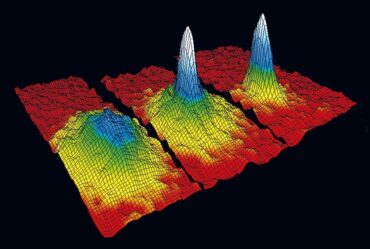
MIT scientists contribute to National Ignition Facility fusion milestone
Unique PSFC-designed spectrometer provides crucial data about the implosion that yielded an historic fusion energy gain.
On Monday, Dec. 5, at around 1 a.m., a tiny sphere of deuterium-tritium fuel surrounded by a cylindrical can of gold called a hohlraum was targeted by 192 lasers at the National Ignition Facility (NIF) at Lawrence Livermore National Laboratory (LLNL) in California. Over the course of billionths of a second, the lasers fired, generating X-rays inside the gold can, and imploding the sphere of fuel.
On that morning, for the first time ever, the lasers delivered 2.1 megajoules of energy and yielded 3.15 megajoules in return, achieving a historic fusion energy gain well above 1 — a result verified by diagnostic tools developed by the MIT Plasma Science and Fusion Center (PSFC). The use of these tools and their importance was referenced by Arthur Pak, a LLNL staff scientist who spoke at a U.S. Department of Energy press event on Dec. 13 announcing the NIF’s success.
Johan Frenje, head of the PSFC High-Energy-Density Physics division, notes that this milestone “will have profound implications for laboratory fusion research in general.”
Since the late 1950s, researchers worldwide have pursued fusion ignition and energy gain in a laboratory, considering it one of the grand challenges of the 21st century. Ignition can only be reached when the internal fusion heating power is high enough to overcome the physical processes that cool the fusion plasma, creating a positive thermodynamic feedback loop that very rapidly increases the plasma temperature. In the case of inertial confinement fusion, the method used at the NIF, ignition can initiate a “fuel burn propagation” into the surrounding dense and cold fuel, and when done correctly, enable fusion-energy gain.
Frenje and his PSFC division initially designed dozens of diagnostic systems that were implemented at the NIF, including the vitally important magnetic recoil neutron spectrometer (MRS), which measures the neutron energy spectrum, the data from which fusion yield, plasma ion temperature, and spherical fuel pellet compression (“fuel areal density”) can be determined. Overseen by PSFC Research Scientist Maria Gatu Johnson since 2013, the MRS is one of two systems at the NIF relied upon to measure the absolute neutron yield from the Dec. 5 experiment because of its unique ability to accurately interpret an implosion’s neutron signals.
“Before the announcement of this historic achievement could be made, the LLNL team wanted to wait until Maria had analyzed the MRS data to an adequate level for a fusion yield to be determined,” says Frenje.
Response around MIT to NIF’s announcement has been enthusiastic and hopeful. “This is the kind of breakthrough that ignites the imagination,” says Vice President for Research Maria Zuber, “reminding us of the wonder of discovery and the possibilities of human ingenuity. Although we have a long, hard path ahead of us before fusion can deliver clean energy to the electrical grid, we should find much reason for optimism in today’s announcement. Innovation in science and technology holds great power and promise to address some of the world’s biggest challenges, including climate change.”
Frenje also credits the rest of the team at the PSFC’s High-Energy-Density Physics division, the Laboratory for Laser Energetics at the University of Rochester, LLNL, and other collaborators for their support and involvement in this research, as well as the National Nuclear Security Administration of the Department of Energy, which has funded much of their work since the early 1990s. He is also proud of the number of MIT PhDs that have been generated by the High-Energy-Density Physics Division and subsequently hired by LLNL, including the experimental lead for this experiment, Alex Zylstra PhD ’15.
“This is really a team effort,” says Frenje. “Without the scientific dialogue and the extensive know-how at the HEDP Division, the critical contributions made by the MRS system would not have happened.”


